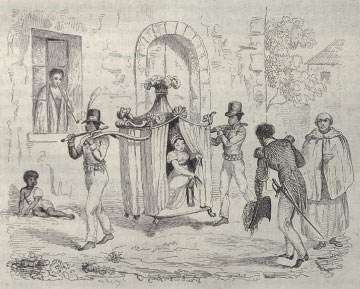Salvador da Bahia, Brazil

Portuguese explorers first landed in northeast Brazil in 1500. In this region, called Bahia, they found large indigenous populations with whom they traded some local commodities, like wood which was used to make dyes. Facing competition from other European nations in the early- to mid-sixteenth century, Portugal began to invest in Brazil as a source of export commodities and imperial wealth. Since Brazil did not appear to have supplies of gold or silver, the Portuguese imported the technology of sugar production to Bahia from their Atlantic islands (Madeira and São Tomé, for example) where the crop had proved successful. This move, in the mid-1500s, launched plantation Brazilian agriculture and large-scale slave importation. By 1600, Brazil was the largest exporter of sugar to Europe.
Planters in Bahia first enslaved indigenous people to work the sugar plantations, but steadily shifted their labor force to one composed primarily of Africans. Brazil continued to import Africans both legally and illegally well into the nineteenth century before officially ending slavery in 1888. During this long span, Brazil received captive Africans from every part of the continent, landing almost five million people in total. Bahia alone imported in excess of 1,300,000 men, women, and children. While the areas of African importation shifted over time, more than 90 percent of the Africans who arrived in Bahia came from either the Bight of Benin or Central Africa.
Because of these strong connections between the two continents, it was possible for Africans and their descendants in Bahia to preserve a variety of African social and cultural forms. Africans in Bahia built religious institutions and social hierarchies, for instance, modeled on those from their African homes. One example of this comes from the experiences of enslaved Muslims, in the early nineteenth century. Beginning in the early 1800s, Bahia received increasing numbers of enslaved Muslims and the Islamic population of Bahia underwent a period of expansion into the 1830s. Muslim community leaders in and around Salvador established schools—almost identical to those in West Africa—where students could learn about Islam and become literate in Arabic. In 1835, about five hundred enslaved and free Muslims launched a large, though ultimately unsuccessful, rebellion in Bahia.
History & Memory
Related Pages:
-
 The Slave Route, Cuba
The Slave Route, Cuba
-
 Scene depicting West Indian mulatto woman with umbrella
Scene depicting West Indian mulatto woman with umbrella
-
 Sculpture, Calabar’s Slave History Museum
Sculpture, Calabar’s Slave History Museum
-
 Religion and Slavery
Religion and Slavery
-
 Ouidah
Ouidah

